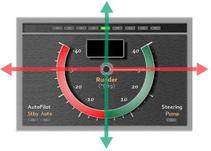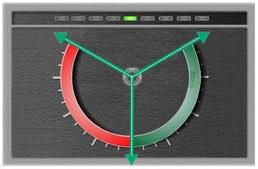- Installation Photo Gallery - ScreenShots - Introduction, Access to configuration page, Configuring the communication ports (Serial & UDP)
- Setting up Sensors and Conditions - List of Values, presentation of values in the Navigation page - Configuring Relative Wind Sensor
- Configuring True Wind Sensor - Configure GAUGE1 as Rudder - Ratio & Offset - Heading Instrument
- Setting up Sensors and Conditions - List of Values, presentation of values in the Navigation page - Configuring Relative Wind Sensor
- Configuring True Wind Sensor - Configure GAUGE1 as Rudder - Ratio & Offset - Heading Instrument
For the configuration of the graphic part of Rudder Indicator we used Ratio=3 and Offset=90.
Ratio & Offset are two parameters helping us to calibrate and adjust the input value to a desired output value.
Ratio & Offset are two parameters helping us to calibrate and adjust the input value to a desired output value.
OFFSET
The Offset for the digital values is ussualy used to correct fixed sensor errors.
For example the air temprerature measured by the sensor is 2 degrees less than the actual temperature. In this case you can add an offset of 2 and the value in digital display will always be (sensor's value +2).
The Offset for the Graphic presentation of a value in a Gauge is important for the adjustment of the 0 position of the Gauge.
For a typical 2D axis system 0 degrees is the right part of the horizontal axis.
Pytheas uses the typical 2D axis model for the presentation of the graphics. In the Rudder instrument the required 0 location in a reference to axis system is at +90 degrees. In order to get a correct presentation of the graphic we have to add a +90 degrees offset.
The Offset for the digital values is ussualy used to correct fixed sensor errors.
For example the air temprerature measured by the sensor is 2 degrees less than the actual temperature. In this case you can add an offset of 2 and the value in digital display will always be (sensor's value +2).
The Offset for the Graphic presentation of a value in a Gauge is important for the adjustment of the 0 position of the Gauge.
For a typical 2D axis system 0 degrees is the right part of the horizontal axis.
Pytheas uses the typical 2D axis model for the presentation of the graphics. In the Rudder instrument the required 0 location in a reference to axis system is at +90 degrees. In order to get a correct presentation of the graphic we have to add a +90 degrees offset.
For the configuration of the Wind indicator that the 0 is at the top of y-axis in order to adjust the input value we add an ofset of -90 degrees.
RATIO
In mathematics, Ratio is a relationship between two numbers of the same kind. Pytheas is using Ratio to create a relationship between input value and the digital or graphic presentation of the value.
For the digital presentation is usually used for unit conversions. If for example you receive wind speed in Knots and you wish to have the speed in m/s you can add a ratio of 0.5144 because 1 Kn = 0.5144m/s
Ratio can be positive or negative
For the graphic presentation is more complicated and ratio is critical in order to create a relation between the input value and the gauge scale.
The Gauges are devided in 3 parts of 120 degrees each and every part is devided in 12 pcs of 10 degrees each
In mathematics, Ratio is a relationship between two numbers of the same kind. Pytheas is using Ratio to create a relationship between input value and the digital or graphic presentation of the value.
For the digital presentation is usually used for unit conversions. If for example you receive wind speed in Knots and you wish to have the speed in m/s you can add a ratio of 0.5144 because 1 Kn = 0.5144m/s
Ratio can be positive or negative
For the graphic presentation is more complicated and ratio is critical in order to create a relation between the input value and the gauge scale.
The Gauges are devided in 3 parts of 120 degrees each and every part is devided in 12 pcs of 10 degrees each
Example
The steering is moving between -40 and 40 degrees.
When the steering is (0) the instrument's needle is at center. When the steering value is 40 degrees Stbd the needle has to jump 120 degrees acording to a theoretical circle.
The equation is Graph value= Ratio x Value -> 120 = Ratio x 40 -> Ratio=3
Conclusion : Graph is using the following equation Graph value= Offset +(Ratio x Value)





